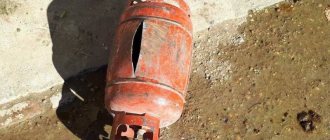The exhaust system of an ATV, unlike a car exhaust system, has a simpler structure. That is why the owners of this vehicle most often replace the muffler or do some tuning to change the characteristics.
More detailed information and prices can be found below.
Do you need to make a muffler for an ATV? Come to us!
Manufacturing a muffler for an ATV in Moscow at a low price
Our specialists can gladly advise you by phone or in a car service center.
Do-it-yourself muffler for an ATV
Home → Tuning → Do-it-yourself tuning of an ATV muffler. Varieties. Methods.
Tuning an ATV muffler can be divided into four types of tasks:
As you can see, each of the above types of muffler tuning solves its own specific problem, but we will try to introduce you to all four types of muffler tuning as briefly and as accessible as possible and give you, as they say, food for thought.
Straight-through mufflers for ATVs.
This type of mufflers is designed to increase engine thrust, lighten the stock design (especially important for sports tuning), and, in addition, these mufflers have a beautiful acoustic effect.
The increase in power occurs due to the fact that all unnecessary elements that can slow down the flow of exhaust gases are removed from the muffler design; roughly speaking, in this case the exhaust flows directly without any obstacles. There are a great many models of direct-flow mufflers for ATVs on sale, but their cost is very high, and therefore craftsmen make direct-flow mufflers with their own hands.
We bring to your attention the simplest diagram of a direct-flow muffler.
And also a finished muffler in section.
And you can appreciate the pleasant and daring sound of a direct-flow muffler by watching this video.
Thermal insulation of the exhaust system of an ATV.
Why is it necessary to thermally insulate muffler pipes and reduce their heat transfer? Most often, this type of tuning is used on ATVs, the exhaust system of which is very close to the gas tank and, during active use of the ATV, brings a lot of trouble to the owner.
There is also an opinion that reducing the heat transfer of the muffler pipes makes it possible to maintain a high temperature of the exhaust gases, which, in turn, increases the flow rate of exhaust gases and has a positive effect on the health of the engine.
To insulate the pipes, a special thermal tape for mufflers is used. There is a tape with a width of 2.5 and 5 cm; for an ATV, the optimal width is 2.5 cm.
When assembling the exhaust system, use a heat-resistant sealant to seal the joints.
Quiet muffler for ATV.
This type of muffler tuning is especially relevant for hunters, but it can also be indispensable for people riding an ATV with a loud exhaust in densely populated areas. The disadvantages include a reduction in engine power when using additional mufflers, although manufacturers claim that this does not happen.
Factory models of additional mufflers (for example, KOLPIN) are very easy to install on an ATV and can also be easily dismantled if necessary, but again it all comes down to money, and ATV riders make an additional can with their own hands and connect it to the main muffler using a small pipe and clamps.
You can listen to the exhaust sound with an additional muffler in the video below.
ATV exhaust pipe snorkel.
Such a snorkel is made solely to avoid water from entering the engine through the exhaust pipe and to easily overcome deep fords.
It is very easy to make the attachment: you can use the muffler pipes of a VAZ car as a donor, selecting the most suitable section in the store, welding the snorkel of the shape and length you need on site, and you can secure the structure with clamps.
If overcoming fords is not a frequent occurrence for you, it is more advisable to use a stainless corrugated pipe (sold in construction or plumbing stores) and attach it with clamps during the “water procedures”.
Well, and finally, we offer you a photo of a frankly brutal exhaust tuning; as you can see, sometimes everything is limited only by our imagination. Good luck off-roading and stay tuned.
Source
Motorcycle muffler
Types of mufflers
A motorcycle muffler is a device that weakens the sound of the engine. Mufflers are needed not so much to reduce noise as to change the timbre. And high-frequency sounds have a more unpleasant effect on the human psyche and ear than low tones.
Many people associate the roar of sports motorcycles with a muffler. And they believe that filling the muffler can reduce the power of the car. But that's not true. When replacing or modifying a muffler, only a small amount of horsepower is lost.
There is an intake and exhaust silencer. And scientific research has proven that if you choose the right basic elements, you can improve the filling of the cylinder. Such mufflers are called resonant mufflers.
When deciding to purchase a new car, the driver has many controversial issues even after he has finally decided on the brand. KIA cars are best suited. What is the secret of success of this model can be found here.
Noise suppression is carried out by the part of the muffler located behind the first partition, and it consists of an acoustic filter. These filters on sports motorcycles are made simpler, since a higher noise level is allowed in sports motorcycles.
When deciding to remake a muffler, you need to remember the following. Sometimes, when improving one part, you have to sacrifice the quality of another. No one has yet succeeded in creating a universal motorcycle.
Manufacturers recommend using factory mufflers for your motorcycle. The muffler cavity becomes covered with carbon deposits, which can close the acoustic filter channels. Therefore, the cavity of the device must be cleaned regularly. The resulting carbon deposits prevent the exhaust gases from escaping, and engine power is reduced. After every five to ten thousand kilometers, mufflers need to be cleaned.
The original mufflers are quite quiet and good. Their disadvantage can be considered their heavy weight and size. Many consider their high price to be a disadvantage. Silencers are produced by many companies, and you can use a non-original muffler if you wish. Most often these are open mufflers. In them, exhaust gases exit the engine without any obstacles. But they make a lot of noise.
Those who love the loud roar of motorcycles can buy the cheapest muffler, which does not muffle anything. But if the roar of the motorcycle does not suit you, then you will have to buy an expensive option.
These mufflers differ in design and material of manufacture. There are four types:
- Titanium. He is considered the best. It's light, looks nice, and doesn't get too hot.
- Aluminum. Light enough. It looks worse than titanium, but there is a drawback. You can get seriously burned.
- Carbon. Looks nice, light and cool. But its significant drawback is that even with vibrations it can crumble.
- Stainless steel. Strong and heavy, but very hot.
Each type of muffler has its own advantages and disadvantages. Therefore, you need to choose for yourself.
DIY straight-through muffler
You can buy a direct-flow muffler in any specialized stores. They are usually of interest to young motorcyclists who dream of high speeds. But real bikers are not sold on stickers from famous brands. They do everything they need with their own hands.
If you want to enter the world for real men, you need to make a direct-flow muffler with your own hands. When riding at normal speed, its noise will not be different from other motorcycles. But as the speed increases, the characteristic rumble of the engine appears. What do I need to do?
- Take a piece of pipe that has a diameter of 60 mm and cut it in half. First, one part is processed and a flange is welded in the middle. The outer part does not change. This is the inlet pipe. In half of the pipe, which is located in the muffler, you need to drill a large number of holes using an electric drill. You need to use a 5-6 mm drill. Recess the flange with a ten-millimeter tip into a pipe with a diameter of 100 mm and weld it.
- We are preparing the second pipe. Weld a flange to the second section of pipe. It should be 80 mm from the edge. This part of the pipe will be inserted into the muffler.
- Carefully lay mineral wool insulation into a pipe with a diameter of 100 mm. This is to combat noise reduction. To do this, roll the cotton wool along the diameter of the pipe and push it to the opposite side.
- Roll up the mesh and lower it inside the insulation that was inserted into the pipe. The mesh should fit onto the pipe with holes.
- Now you need to insert the flange with the pipe, which you prepared in advance, into the pipe with the short end. It needs to be recessed to a depth of 10 mm and welded.
- You can cut off the fastening elements from the old muffler and transfer them to the direct-flow muffler by welding them.
Muffler modification + extra. muffler
So another modernization, this time – a muffler.
First, a little theory: the designers of our quad designed it in such a way that the CDI ignition system gives a very weak spark for such an engine size, so the unburnt air-fuel mixture flies out into the pipe along with the exhaust, and in order not to pollute the environment, they decided to burn it all out in the muffler! And to do this, they placed ceramic honeycombs inside the muffler and came up with an “ecological box” that sucks fresh air into the muffler so that all unburnt fuel and other “poop” burns on these hot honeycombs (like in a car’s catalytic converter).
DIY ATV muffler tuning
Tuning an ATV muffler can be divided into four types of tasks:
— Reduced exhaust noise.
— Increased engine power by installing a direct-flow muffler.
— Installation of a snorkel on the exhaust pipe of an ATV (for those who like to swim).
As you can see, each of the above types of muffler tuning solves its own specific problem, but we will try to introduce you to all four types of muffler tuning as briefly and as accessible as possible and give you, as they say, food for thought.
Tuning at the Lyokha Exhaust car service center.
The best specialists of our Lyokha Exhaust car service center will be able to competently perform tuning, manufacturing or repair of the muffler of your ATV at the best prices! All installation work will have its own guarantee. You will be offered various tuning services to also improve the performance of the vehicle. You can resolve any issue at the address: Moscow, Sokolnichesky Val 1, building 1.
ATV muffler - tuning, manufacturing, repair - photo, video, Instagram
Also, you can read Why do you need a flame arrester?
Straight-through mufflers for ATVs
This type of mufflers is designed to increase engine thrust, lighten the stock design (especially important for sports tuning), and, in addition, these mufflers have a beautiful acoustic effect.
The increase in power occurs due to the fact that all unnecessary elements that can slow down the flow of exhaust gases are removed from the muffler design; roughly speaking, in this case the exhaust flows directly without any obstacles. There are a great many models of direct-flow mufflers for ATVs on sale, but their cost is very high, and therefore craftsmen make direct-flow mufflers with their own hands.
ATV muffler repair.
The muffler performs a number of main functions:
- Noise reduction;
- Exhaust gas removal;
- Neutralization of unpleasant odors;
If for some reason signs such as:
- Reduced engine power;
- The appearance of an unpleasant odor;
- Appearance of noise.
This means that the muffler has some problems and repairs should be made in the near future so that more serious and detailed repairs do not have to be made in the future.
Thermal insulation of ATV exhaust system
Why is it necessary to thermally insulate muffler pipes and reduce their heat transfer? Most often, this type of tuning is used on ATVs, the exhaust system of which is very close to the gas tank and, during active use of the ATV, brings a lot of trouble to the owner.
There is also an opinion that reducing the heat transfer of the muffler pipes makes it possible to maintain a high temperature of the exhaust gases, which, in turn, increases the flow rate of exhaust gases and has a positive effect on the health of the engine.
To insulate the pipes, a special thermal tape for mufflers is used. There is a tape with a width of 2.5 and 5 cm; for an ATV, the optimal width is 2.5 cm.
The tape must be pulled very tightly, and the turns must be secured with thin stainless wire, since the tape tends to stretch over time.
When assembling the exhaust system, use a heat-resistant sealant to seal the joints.
Quiet muffler for ATV
This type of muffler tuning is especially relevant for hunters, but it can also be indispensable for people riding an ATV with a loud exhaust in densely populated areas. The disadvantages include a reduction in engine power when using additional mufflers, although manufacturers claim that this does not happen.
Factory models of additional mufflers (for example, KOLPIN) are very easy to install on an ATV and can also be easily dismantled if necessary, but again it all comes down to money, and ATV riders make an additional can with their own hands and connect it to the main muffler using a small pipe and clamps.
ATV exhaust pipe snorkel
Such a snorkel is made solely to avoid water from entering the engine through the exhaust pipe and to easily overcome deep fords.
It is very easy to make the attachment: you can use the muffler pipes of a VAZ car as a donor, selecting the most suitable section in the store, welding the snorkel of the shape and length you need on site, and you can secure the structure with clamps.
If overcoming fords is not a frequent occurrence for you, it is more advisable to use a stainless corrugated pipe (sold in construction or plumbing stores) and attach it with clamps during the “water procedures”.
Source
MY MOTORCYCLE
Today, society and the governments of the world's leading countries are highly concerned about environmental problems, engineers are developing ultra-modern electric vehicles, and internal combustion engines and exhaust systems of cars and motorcycles are designed in such a way as to release as little harmful substances and carbon dioxide into the atmosphere as possible.
However, at the same time, the demand for powerful engines, high-speed cars and motorcycles, as well as all-terrain SUVs and ATVs is not falling at all. On the contrary, powerful engines are attracting more and more attention and fans of such equipment are increasingly thinking about making their favorites even more powerful on their own, squeezing a few extra horsepower out of the engine, adding stylish body kit elements and external tuning. In a word - to make their vehicle as different as possible from stock and have a better chance of outperforming its rivals.
One of the first components to be replaced is usually the exhaust system. There are a lot of reasons to get rid of the standard muffler - we will talk about them using the example of an ATV. Often, the exhaust pipe of an all-terrain vehicle is the first place where the main enemy of any equipment appears - corrosion. It affects the muffler not only from the outside, but also from the inside. If the external factors due to which the first “saffron milk caps” appear on the metal include, first of all, weather conditions and dirt, which ATVs love so much, then inside the exhaust system is exposed to a much more aggressive effect. Hot exhaust gases constantly pass through it, condensation from moisture and acid settles on the internal surfaces - it is not surprising that not only the walls, but even the welds are subject to corrosion. It is naive to believe that this problem can only be solved by cleaning and painting the muffler. Those who have already encountered such a problem clearly know that it is better to change the stock muffler.
How to make a homemade muffler for a motorcycle
One of the most important disadvantages of any motorcycle is the unpleasant sound produced by a high-speed engine - its tonality has a depressing effect on the human nervous system. At the same time, the volume of such sounds leaves no doubt that they will be heard by people within a radius of several city blocks. That is why engineers created a special muffler for a motorcycle, which not only reduces the volume of unpleasant sounds, but also seriously changes their tonality. However, any obstacle in the path of exhaust gases forces you to reduce engine power for the sake of its safety. Therefore, many motorcycle owners are interested in how to make two-wheeled vehicles more powerful without sacrificing their health and the comfort of those around them.
High-quality forward flow
Despite the apparent complexity of such an operation, you can make a direct-flow muffler for a motorcycle yourself, saving up to $1000 on the purchase of a product from a famous brand. First of all, you should decide on the type of materials you will use in your work. Experts give the following recommendations:
- The best option would be titanium, since it has very high strength with minimal weight. However, bending titanium sheet to produce a muffler will be very difficult, as will finding welding equipment. You don't even need to mention the incredibly high cost of titanium;
- Aluminum is excellent for muffler production for the reasons described above. However, when using it, it will be problematic to connect the device to the motorcycle engine;
- Stainless steel has a large mass, but is durable and quite easy to bend. To weld a motorcycle component from this material, you will need specialized equipment;
- Ferrous metal is heavy, has low reliability and requires repeated processing. However, it is recommended for use by beginners due to the ease of bending and welding.
The thickness of the metal should be approximately 0.8–1.5 mm so that it can easily bend and weld without burning. Once you've selected the metal that best suits your muffler, spend some time researching the required equipment to cut and weld it.
Now it’s time to make muffler patterns for a motorcycle. The first thing to make is the resonator cone, which connects the device you are making to the motor of the two-wheeler. You can also make it yourself - to create the correct pattern, you need to remember that the planar projection of the cone is a sector of a circle. Next, pipes are taken that correspond to the diameter of the exhaust system - there should be three of them. Remember that it is better to take pipes for a motorcycle muffler ready-made, although if desired or if there are no suitable materials, you can weld them yourself.
The first pipe will be approximately 50 mm long (more if necessary) - it will connect the engine to the new muffler. The second will serve as an outlet - it needs to be given a similar length. The third will go inside the muffler housing and will serve to reduce the intensity of sounds. To get a quiet enough muffler, you need to make the last pipe long enough. However, it is worth understanding that increasing it will lead to a lengthening of the motorcycle muffler housing.
All that remains is to cut out the body itself—whether it will be cylindrical or flattened depends only on your desire. The minimum case diameter is 100 mm, but if possible it should be 150–170 mm. The sides of the body are made of similar sheet metal, after which holes for pipes are made in them. The first and second pipes described above are processed, after which they should form a flange that allows them to be firmly secured inside the muffler. You need to drill a lot of holes in the third pipe - the best option would be holes with a diameter of 1 mm in increments of 10-15 mm, then insert it inside the body and securely fasten it between the first and second.
The last step in assembling a motorcycle muffler is to fill it with a non-flammable material that dissipates sound - fiberglass is suitable for this. It needs to be laid as tightly as possible in order to achieve maximum muffling of unpleasant sound. Now you can finally weld the motorcycle muffler and install it on the vehicle. If you are doing such work for the first time, it is better to first try to make all the patterns from thick cardboard and try on a similar homemade muffler for your motorcycle. If you make a mistake, you will be able to understand exactly what the mistake is and correct it without wasting expensive metal.
Alternative options
If you are interested in how to make a muffler quieter without losing precious horsepower, you can use a scheme that has been used in Chinese motorcycles for quite a long time. However, it is worth remembering that this option is only suitable for the production of mufflers for low-power motorcycles, whose performance does not exceed 40 hp. With. A pipe is inserted into the muffler body two-thirds of its length, the last 10 centimeters of which are covered with small holes according to the scheme described above. Having installed the inlet pipe, we are engaged in the outlet, which will be a pipe of a slightly larger diameter, inserted from the opposite side by two-thirds. It also remains to drill holes in 10 centimeters located closest to the motorcycle engine - such a muffler will represent a compromise between forward flow and the factory product.
If you know the structure of a motorcycle muffler, you can probably make a forward flow from an ordinary part. After opening the housing, you will see tubes that pass through special chambers, first to the end of the muffler, and then back and again to the exhaust pipe. These, as well as the motorcycle's catalytic converter, will need to be removed to achieve the desired effect. The perforated tube mentioned in the previous diagrams is inserted inside and wrapped with fiberglass. Of course, you can buy a special synthetic material used in the packing of original mufflers, but it will obviously cost more.
If you already know how to make a motorcycle muffler that fully meets your requirements, do not forget about fine-tuning the exhaust - for this you need to select the optimal diameter and position of the pipes, as well as the density of the holes. It is almost impossible to achieve an ideal result without using a special stand, so you will have to be content with approximate parameters obtained experimentally. In addition, after installing a different muffler, the motorcycle engine should be retuned. Modern injection engines will require the installation of new firmware, but carburetor motorcycles get by with a simple adjustment of the fuel system. Not every motorcyclist can do this kind of work, so it is quite possible that you will have to go to a specialized service center.
Independent work
Making a motorcycle muffler can be quite simple, but will it fully meet the requirements for it? Get ready for the fact that the first product you make with your own hands will require certain modifications and many hours of adjustments. However, practice shows that the second or third time it is possible to make a muffler for a motorcycle that initially meets all the required parameters. Sometimes it happens that it is not possible to make the required muffler for a motorcycle at all - this may be due to a lack of experience or certain design features of the equipment. In this case, it is better to buy a finished product from a well-known manufacturer or order the production of a direct flow from a real professional.











